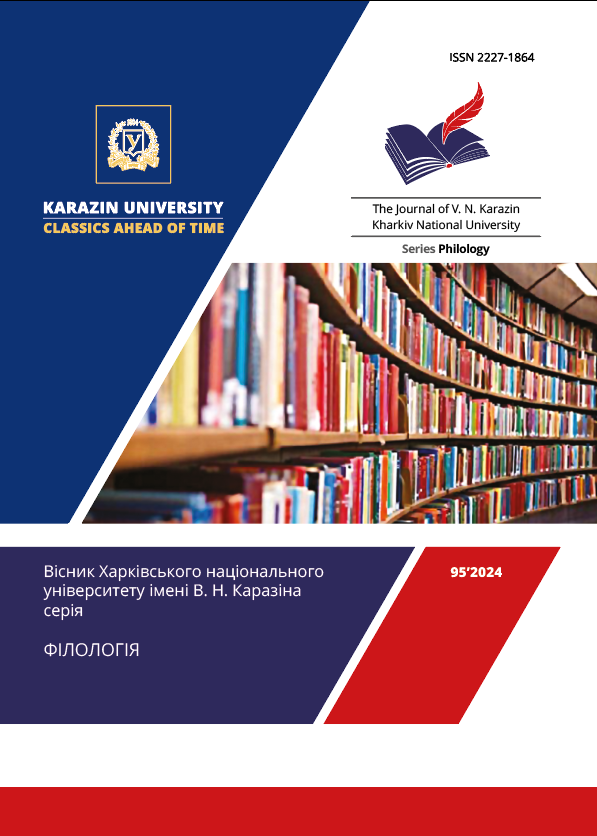Polysemy of the Temporal Adverb JAM in Latin
Abstract
One of the most important types of semantic relations in the lexical and semantic system of languages is polysemy. The study of polysemy in Latin is extremely relevant, as it helps to understand the origin and development of polysemy in European languages that based on it.
The phenomenon of polysemy has attracted and paid the attention of scholars for centuries: from theoretical foundations to practical applications. Despite the considerable number of studies devoted to this problem, polysemy in Latin, in particular temporal vocabulary, remains insufficiently studied.
The purpose of this article is to find out the polysemy of the adverb JAM as one of the most frequently used words in the temporal vocabulary on the basis of the work “Satyricon” by Gaius Petronius Arbiter, to identify its lexical meaning depending on the tense used in the sentences, and to study its combination with other words.
The study showed that JAM is used with all tenses, acquiring different meanings according to the context. With the future tense: now, immediately, soon, expressing the near future; immediately, then, indicating the order of actions. With the present tense: already, at this time, now, just, at the moment, indicating an action that, as opposed to the past or future, is taking place at the moment of speech. With the past tense: already, emphasising the completion of an action in the past or its imminent occurrence; long ago for remoteness in the past tense; already, up to now, until now as a continuation of the past; a little earlier, just now, already, indicating the precedence of the action; no longer with the negation ne, nec, non, emphasising the completion of an action or state.
Most often, JAM is used with the past tense (65%), the present tense (23%), and the future tense (12%).
Despite numerous studies, polysemy still remains a complex subject for scientific analysis. One of the main problems is determining the criteria for distinguishing between different meanings of a word. In Latin, the use of large corpora of texts is considered promising, which will allow us to obtain statistical data on the distribution and use of different word meanings.
Downloads
References
Busel, V. T. (Ed.) (2005). A large explanatory dictionary of the modern Ukrainian language. Kyiv; Irpin: VTF Perun [in Ukrainian].
Zahnitko, A.P. (2012). Dictionary of Modern Linguistics: Concepts and Terms. (Vol. 3). Donetsk: DonNU [in Ukrainian].
Klymenko, N. B. (2021). Lexical polysemy in Ukrainian Eastern Steppe dialects. Linguistic studies, 41, 266-275. DOI: https://10.31558/1815-3070.2021.41.27 [in Ukrainian].
Lysychenko, L. A. (2008). Ambiguity in the lexico-semantic system: structural, semantic, cognitive aspects. Kharkiv: Osnova [in Ukrainian].
Bilodid, I.K., Buriachok, A.A., & Vynnyk, V.O. (1976). Dictionary of the Ukrainian language. (Vols. 1-11). Kyiv: Naukova dumka [in Ukrainian].
Soha L. V. (2016) Polysemy as a linguistic universal in the system of European languages. Pedagogical Sciences, 4 (25), 90-103 [in Ukrainian].
Taran A.A. (2022). Polysemy as a sign of language dynamics. Linguistic Bulletin, 33, 118-124. DOI: https://10.31651/2226-4388-2022-33-118-124 [in Ukrainian].
Valpy, F. E. J. (1828). An Etymological Dictionary of the Latin Language. Retrieved from URL: https://books.google.com.ua/books?id=m2QSAAAAIAAJ&printsec=frontcover&redir_esc=y#v=onepage&q&f=false
Charlton, T. L., Short, Ch. (1879). A Latin Dictionary. Oxford: Clarendon Press. Retrieved from URL: http://www.perseus.tufts.edu/hopper/text?doc=Perseus:text:1999.04.0059
Michiel de Vaan. (2008). Etymological Dictionary Of Latin. Retrieved from URL: https:/ /archive.org/details/de-vaan-michiel-etymological-dictionary-of-latin/page/291/mode/2up
Dumesnil, M. J. B. G. (1819). Latin Synonyms: With Their Different Significations: and Examples Taken from the Best Latin Authors. London. Retrieved from URL: https://play.google.com/store/books/details?id=CJ5FAQAAMAAJ&rdid=book-CJ5FAQAAMAAJ&rdot=1
Polysemy. Cambridge Dictionary. Retrieved from URL: https://dictionary.cambridge.org/dictionary/english/polysemy
Ullmann, S. (1951) The principles of semantics. Glasgow: Jackson, Son and Co.[in English].




